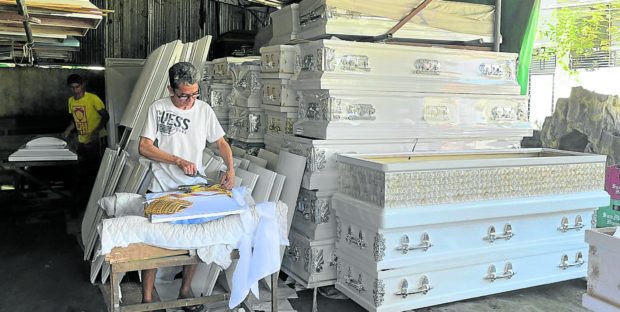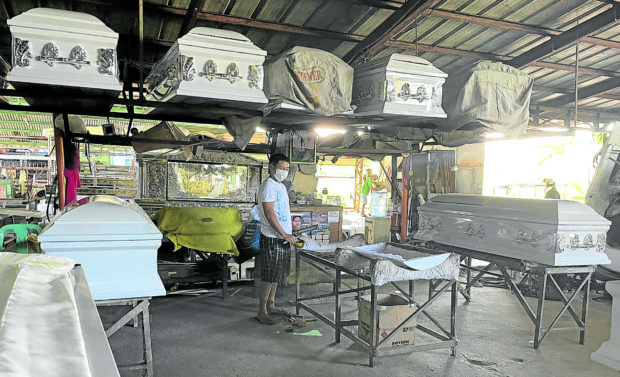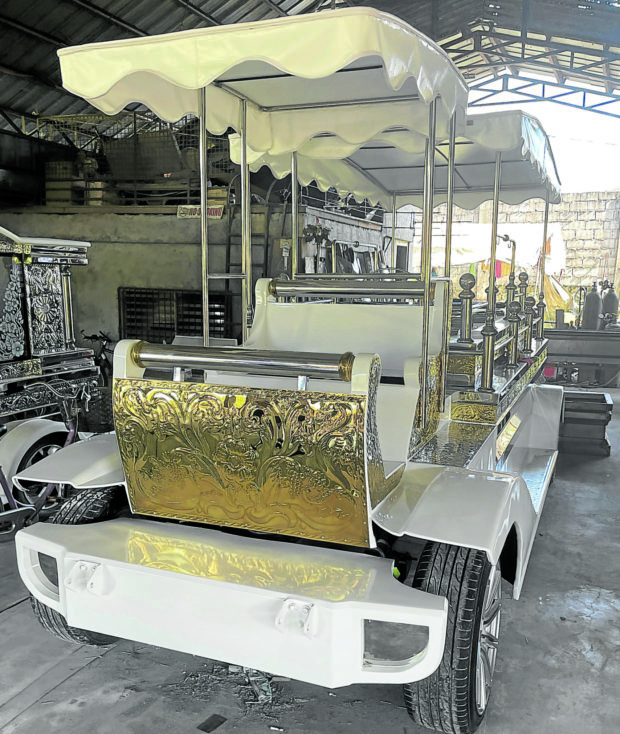In PH coffin capital, death isn’t good news

VALUING RESPECT In Pampanga’s smallest town of Sto. Tomas, registered coffin makers produce more than 60,000 caskets a year, more than the number of its residents. But artisans do not just regard it as a business; they make quality caskets as a form of respect for the dead. (Photo by TONETTE OREJAS / Inquirer Central Luzon)
STO. TOMAS, Pampanga, Philippines — Acknowledged as the “casket capital” of the Philippines by the Department of Trade and Industry, this town is living up to its name by ensuring that the rising demand for coffins amid the pandemic is met.
But Danilo Aniciete, a local coffin maker, takes this increase in sales of caskets matter-of-factly, without a tinge of pleasure.
As passed down by elder craftsmen, like pioneer Aquilino Tayag of the House of Woodcraft, the rule of thumb is to “respect the dead by making quality coffins,” Aniciete told the Inquirer on Friday.
So as his workshop on P. Gomez Street buzzed on Friday with the sound of metal sheets being bent or of spray paint machines, the 47-year-old businessman-cum-municipal councilor blurted poker-faced: “Deaths by COVID-19 have increased the demand for our coffins.”
His enterprise, Dhansky Metal Caskets, has seen a 20 to 30 percent increase in sales.
Article continues after this advertisementFrom selling an average of 30 to 40 caskets monthly before March 2020 when the COVID-19 pandemic was declared and Luzon was placed on a hard lockdown, Aniciete has been meeting a demand of 50 pieces monthly on consignment or cash.
Article continues after this advertisement“It is quicker to sell in the past months,” observed Maynard Gomez of ANCC Casket.
The cheapest metal caskets now sell at P6,000 each while wooden coffins are priced at P3,000. These were P500 cheaper before the pandemic. Caskets for babies are free and given away as a tradition among coffin makers.

DEMAND UP Stocks at Dhansky Metal Caskets are few because COVID-19 deaths increased the demand for coffins made in Sto. Tomas that the Department of Trade and Industry dubbed the casket capital of the Philippines. (Photo by TONETTE OREJAS / Inquirer Central Luzon)
Safety protocols
For the first time since Aniciete made metal caskets in 1999, owners or managers of funeral parlors have come to Sto. Tomas recently, buying straight from the makers.
“Others make down payments to make sure they can have their goods at the time they want,” he said.
He remembered that at one time, probably last August when new COVID-19 cases surged, several makers ran out (“naubusan”) of coffins to sell.
Pampanga recorded 2,519 deaths due to COVID-19 complications as of Oct. 27, based on the record of the provincial COVID-19 task force.
The brisk sales happened because suspected, probable, and confirmed COVID-19 fatalities have to be either cremated or buried in sealed caskets in elaborately strict safety protocols, as instructed in the Department of the Interior and Local Government’s Memorandum Circular No. 2020-063, a health official said.
No public viewing is allowed and gathering is limited to relatives in the same household, according to the memo.
Sto. Tomas coffin makers, mostly based in Barangay San Vicente, are not new to meeting demands arising from disaster situations.
They have been tapped by local governments in making basic caskets for those who died during the onslaught of Supertyphoon “Yolanda” (international name: Haiyan) in 2013, Typhoon “Pablo” (Bopha) in 2012, and Tropical Storm “Sendong” (Washi) in 2011.
While this industry catering to the dead is not in its death throes, it still needs capital infusion, said Aniciete.
Not counting the biggest, St. Peter Caskets, municipal records showed 100 registered enterprises. By Aniciete’s estimates, there are as many as 100 backyard, unregistered coffin producers in the town.
According to Gomez, the unregistered businesses are able to drop prices because its owners do not pay taxes.

SPECIAL HEARSE Aside from making metal coffins and providing funeral services, the shop run by Sto. Tomas Councilor Danilo Aniciete also rents out or sells horse-drawn hearses to give the departed a special place during the funeral cortege. (Photo by TONETTE OREJAS / Inquirer Central Luzon)
Competition
The registered manufacturers also deal with competition resulting from the popularity of cremation services and the influx of imported coffins from the United States or China.
The industry has no price and quality regulators. The local government does not intervene through capital or training support, letting the market prevail.
Artisans here learned by apprenticeship, with their skills honed by working with longtime coffin makers.
Aniciete copes by venturing into other related businesses, like funeral services and building horse-drawn metal carriages used in funeral processions.
Alfredo Batac, 74, stays afloat by specializing in velvet-covered coffins.
Others ventured where competition is not stiff: Mario Nunag built a factory in Zamboanga City, Alexander Canlas moved to Iloilo province, Leonora Gomez relocated to Palawan, Boy Pingul to Arayat town in Pampanga and former Mayor Romeo Pineda to Olongapo City and Zambales.
Editha Castro’s Triple K excelled in metal coffins, shipping these to Australia. Others like Concha Lapid keep the business small on purpose.
When the pandemic eases next year and health protocols will allow cultural activities to resume, Sto. Tomas officials are looking forward to showcase the stars of its “death industry” by featuring the coffins of Barangay San Vicente in the Sabuaga (shower of flowers) Festival on Easter Sunday.
But Sto. Tomas is also eager to introduce and promote through the festival its other livelihood activities and products in six other villages that give life to this town that is home to more than 42,000 people—clay pots of Sto. Niño Sapa, rice and vegetables of Sto. Rosario, fishery of Poblacion, garments of Moras dela Paz, stainless jeepneys of San Matias, and poultry of San Bartolome.